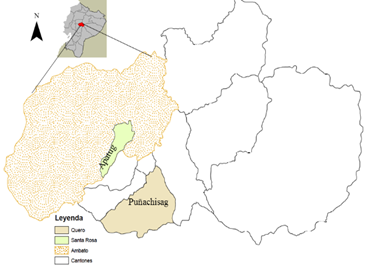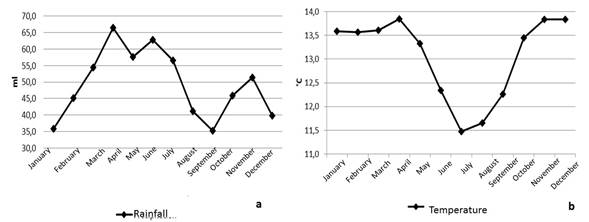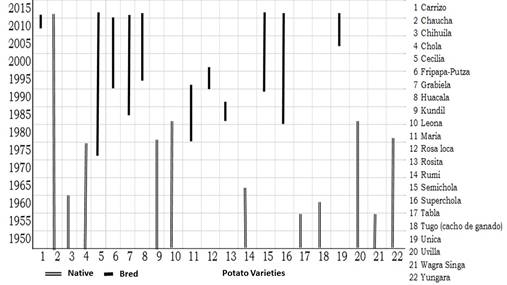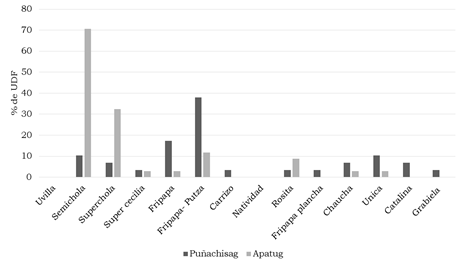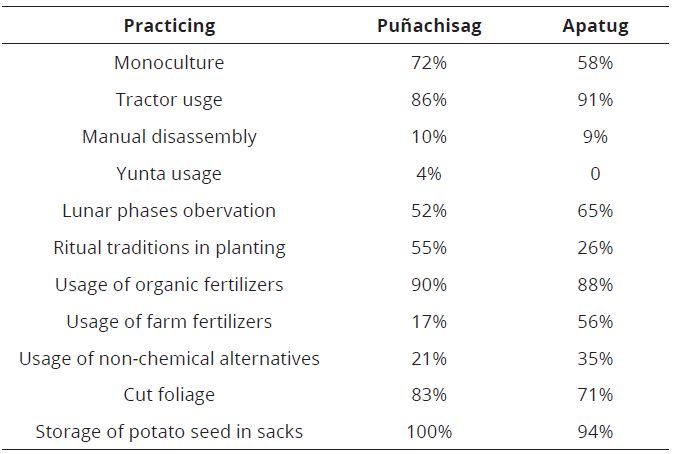Introduction
The cultivation of potatoes in the Andean region has thousands of years of practice. Their domestication was carried out by the Andean cultures from bitter tubers (Rodríguez, 2010). Cultivation techniques were developed based on empirical experimentation whose results were capitalized and transmitted from generation to generation (Altieri, 2009). Potato cultivation also demanded a range of knowledge including climate (rainfall, frost, and drought), influence of astronomical cycles (lunar phases and constellations), rotations and crop associations, among others.
On the other hand, for hundreds of years the potato was the base crop of the so-called Andean chakra, which consisted of associated potato crops with other tubers and Andean roots such as mellocos (Ullucus tuberosus Loz.), mashuas (Tropaeolum tuberosum Ruiz and Pav.), goose (Oxalis tuberosa Mol.), and jiccamas (Pachyrhizus erosus L.). In addition, some grains such as quinoa (Chenopodium quinoa Willd.) and maize (Zea mays L.) (Altieri, 2009). The colonization brought new crop species, the fields were enriched with exotic species (cabbage, cauliflower, lettuce, peas and beans) (Ojasti, 2001; Rodríguez, 2001), as well as the monoculture and use of agrochemicals were encouraged in more recent centuries. These agroecological arrangements have allowed to farmers take advantage of interactions between species to reduce the incidence of pests and diseases and to have a greater diversity of products for the family shopping basket (Altieri, 2009). However, from the decade of 1970 with the rise of the green revolution, the agriculture modernization was encouraged throughout mechanization, use of synthetic fertilizers, hybrid seeds and phytosanitary seeds (Gondard & Mazurek, 2001) , Which affected traditional production systems and, therefore, ancestral agricultural knowledge (Perdomo, 2012).
The use of chemical fertilizers and control of pests and diseases with pesticides increased yields, which led to the massive use of new technologies by peasants (Kroschel et al., 2013). On the other hand, globalization and new market requirements have led to soil overexploitation, a weakening of genetic resources and peasant traditions, etc. The impact of these technological packages affected many peasants. According to Ospina et al. (2008), 82% of potato farmers are exposed to pesticides and herbicides, putting their health at risk.
In this context, there is a limited local knowledge about the current situation of ancestral practices related to potato cultivation, as well as the factors which are influencing these changes. The aim of this research was to analyze the permanence of ancestral practices in the peasants of the communities of Puñachisag and Apatug, Ecuador under the assumption the paradigm changes in potato cultivation are due to external factors rather than internal factors which are modifying traditional ways of growing potatoes in the region.
Materials and methods
The communities of Puñachisag and Apatug, are located in the Quero and Ambato cantons, Ecuador. Figure 1, shows the geographical location of the evaluated communities, which were selected for their tradition in the potato cultivation.
The community of Puñachisag, is located in the canton of Quero, Ecuador 1km from the cantonal headland. Geographically it is located towards the eastern mountain range in the flanks of the mountain formation called the Llimpes, in front of the Tungurahua volcano. The coordinates of the community center are 1 ° 24'14.10 "S 78 ° 35'50.93" W and has an estimated average temperature of 12.7 ° C (Aguirre, 2012). This community has a long tradition in the potato cultivation. This location performs an irregular topography with small undulations. The upper part does not have irrigation system. It is located between 3100 and 3400 m. a. s. l. and has about 450 families, most of whom speak Spanish and have a total estimated population of 1000 inhabitants. On average, a family has between 2.5 and 3 ha of land.
While, the community of Apatug is located in the foothills of the mountain Carihuarazo near the hill Tzunanzta, Ecuador. The center of the community is between the coordinates 1 ° 19'47.51 "S and 78 ° 41'42.41" O at an altitude of 3370 m. a. s. l. Apatug, belongs to the Parish Santa Rosa Canton Ambato, Ecuador. It is located 12 km from the city of Ambato and is characterized by the practice of peasant agriculture in smallholdings (0.5 ha / UPA Productive Agricultural Unit). The population is 100% indigenous (they speak the language Quichua and Spanish, respectively).
The soils in the lower part are sandy-loam and in the upper part are clayey, most of the territory is flat with slight slopes and has about 450 families and an estimated population of 900 inhabitants. The soils of the two communities are sandy in the lower part and clayey in the upper part, with volcanic origin constantly enriched with Tungurahua volcanic ash.
Semi-structured interviews were carried out with 29 and 34 farmers (producers), representing an Agricultural Production Unit (APU), of the communities of Puñachisag and Apatug. Interviews were conducted between November 2015 and February 2016, provided that authorization was requested from the authorities of the indicated communities. Information has been collected since 1950, based on the memory of older farmers. The data were analyzed with the statistical program SPSS 18(r). To know the pesticide residues, dithiocarbamate analyzes were performed in 4 samples of freshly harvested potatoes, in the laboratory of the Ecuadorian Agency for Quality Assurance of Agro (Agrocalidad).
In Puñachisag - Ecuador, 65.5% of farmers interviewed were women and 34.5% were men. The average age was 47.7 years. In the Apatug community, 58.8% of the interviewees were men and 41.2% were women; the average age was estimated at 40.8 years. In general, the evaluated population was between 15 and 24 years (11%), between 25 and 34 years (19%), between 35 and 44 years (22%), between 45 and 54 years (24%), 64 years (13%), 65-74 years (5%) and more than 75 years (6%). Information related to climate knowledge was also copied based on peasants appreciation of climate cycles.
Results and discussion
Potato cultivation in the analyzed communities, showed a mixture of traditional and modern practices. However, the analysis focuses on practices of ancestral origin.
Ancestral calendar of potato planting
Based on field information, the ancestral calendar of potato plantings was reconstructed along the year. As base of the calendar, was used the chacana (Andean symbol, which means ladder or object like bridge, in form of square cross). According to Van Kessel (2000), it represents the four solstices and in each one of them, it was accompanied with rituals. For example, the Inty Raymi had as objective to ask the sun makes its route to guarantee the sowings. So the planting and harvest transitions had to be ritually accompanied by human being (Timmer, 2003). In the evaluated communities three seasons of sowing were found:
The first planting took place between October and November, taking advantage of the humidity of sporadic rains. The following months, december, january and february (dry months), contributed to reduce the disease proliferation, whereas the rains of march and april, favored the last phase of the culture (Figure 2).

Figure 2 Calendar of potato and festive cultivation observed until the 1970s, reconstructed based on field information and contributions from Timmer (2003). In the center is the Chacana (Andean cross), emphasize the four solstices and the ancestral festivities, in the first circle are located the months of the year; In the second circle the climatic periods; In the third and fourth circle the seasons of sowings and old harvests of potatoes are shown; And the last circle of Catholic religious festivities.
This potato planting was harvested between the months of march and april, which coincided with the festivities of Paukar Raymi and Easter, in which they prepared traditional meals (fanesca), where the potato was a basic product together with a series of Andine grains and cucurbits.
The second planting, took place between february and march, taking advantage of the rains of april, may and june. These crops, due to the presence of high humidity, were more prone to disease attack. The harvest of these plantings, were made between june and july, which coincided with the Inti Raymi festivities which, due to religious influence, were also celebrated with the feasts of Corpus Christi.
The third planting, took place between july and august, the cold months, and in this case, the peasants tried to ensure the seeds did not sprout before the coldest days. This planting was harvested between november and december and coincided with the ancestral day of the dead, in which the potato was a staple food for traditional foods (potatoes with guinea pigs).
In all cases, sowing coincides with climatic cycles and harvest, with religious festivities. The results suggest that sowings and harvest, were also intended to supply family and community food demand rather than market. On the other hand, it is very evident the religious syncretism present between prehispanic and catholic festivities. In this sense, the peasant family claimed to have potatoes throughout the year and with special emphasis on the months of festivities. Figure 2, shows the solstices, ancestral festivities and potato planting and harvest.
Although, according to producers, many practices based on the ancestral calendar were observed until the decade of 1970 in the evaluated communities, crop and sowing cycles are still maintained among some farmers. In Puñachisag, sowings are carried out during all months of the year, in greater proportion in march, april, may and june and the highest crops are in january, february and august. In Apatug, the months of greatest planting are december, june, july and august.
According to the peasants, the pattern of rains are maintained. The greatest rainfall occurs between february and july, while frosts are reported in the months of november, july and august (Figure 3).

Figure 3 Climatic cycles and sowing of the current potato crop (2016). The outer circle shows the months of the year, the scale represents the percentage of the evaluated producers. The lines, the variables. For example, in Apatug crops (continuous line) 45% of farmers who sowed in March.
Comparing the current calendar with the ancestor, nowadays, the planting seasons are more dispersed, therefore also the crops. There is no clear alignment with religious festivities. Besides, several informants consider the sale price in the market as an important issue for sowing planning. This dispersion would also be explained in part by the local climate changes according to Pomboza-Tamaquiza et al. (2015), which shows a trend of temperature increase between 1986 and 2015.
Comparing the ethnoclimatic knowledge with rainfall data and temperatures (Figure 4), reported from the meteorological station closest to the evaluated communities, a very important coincidence was found between the months of higher rainfall as well as frost months.
Management of potato varieties
According to the producers in Puñachisag, at least six varieties of native potatoes were cultivated in the decade of 1950: Chola, Cumbila or Frayla, Leona, Santa Rosa, Santa Rosa roja and Uvilla (Monteros et al., 2010). Throughtout the decade of 1970 and 1980, new improved varieties arrived: Única, Catalina, Esperanza, Cecilia, Huacala and Semichola. These varieties arrived to the community, some promoted by technology transfer institutions such as the Ministry of Agriculture and Livestock and the National Institute of Agricultural Research (INIAP) such as Cecilia variety (Albornoz et al., 2001) and others by trade of peasants with neighboring countries of Peru and Colombia. From this last one, the Única and Huacala varieties were introduced, while from Peru, the Rosita variety (Pumisacho & Sherwood, 2002).
In Figure 5, we can observed how in Puñachisag between 1950 and 2016 peasants handled at least 23 varieties of potatoes (5 native and 18 bred).
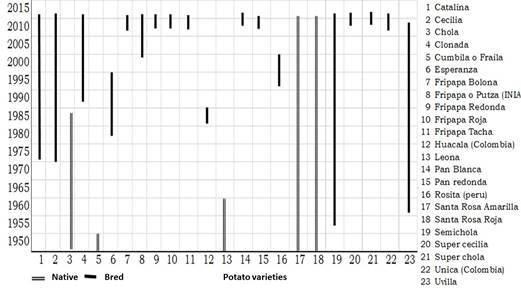
Figure 5 Evolution of potato varieties in Puñachisag. The X axis shows years, on the Y axis, the varieties of native and improved potatoes reported by farmers. In the column on the right the number is displayed according to the varieties analyzed. For example, the Chola (3) variety was reported to be cultivated until 1985.
Also we observed that only two varieties of native potatoes still continue cultivated, as well as the greatest number of bred varieties were introduced in the last 15 years.
In Apatug (Figure 6), between 1950 and 2016, according to the statements of the farmers interviewed, at least 22 varieties of potatoes (11 native and 11 bred) were managed.
Between the decade of 1950 and 1960, 11 varieties of native potatoes were cultivated and from 1975 onwards varieties of bred potatoes were introduced that were cultivated in the highlands, on lands delivered by the State throughout Agrarian Reform (Gondard & Mazurek, 2001; Pumisacho & Sherwood, 2002). In 2016, eight introduced varieties and only one native variety were grown. The results suggest there is a high genetic erosion, according to informants the entry and development of new varieties occurred due to state technology transfer programs.
In relation to the most cultivated varieties, the farmers of Puñachisag, prefer the Fripapa-Putza variety (35%), while in Apatug, the Semichola variety (70%). In the first case, according to the peasants, they prefer this variety for the high yield (41 t.ha-1), (Pumisacho & Sherwood 2002). It was estimated at the local level between 35 and 40 t.ha-1 by the high market demand (industry of french fries) and for the good price in the market (10USD. 45kg-1 in April 2016). In this case, the objective of production seems to be more market oriented rather than family consumption. In the second case, the preference for the cultivation of the Superchola variety, which reports an estimated yield of 30 t.ha-1 (Pumisacho & Sherwood 2002) and a local level of 22.5 t.ha-1, would be more related to family consumption.
This variety has good culinary characteristics for soups, purees, etc. On the other hand, results of dithiocarbamate analysis on samples of potato varieties Semichola and Fripapa, indicates pesticide residues below the detectable limit (detection limit 59 ppb and limit of quantification 178 ppb) according to the Maximum Residue Limits established by The Directorate-General for Health and Consumer Affairs of the European Union 2008-2013. By the way, when the peasants have surplus of the Superchola potato, it is sold at a good price in the market (15USD / 45kg - April 2016). Figure 7, shows the different varieties of potatoes and the number of informants who reported cultivating them.
Rotations and associations in the cultivation of potatoes
According to the producers in Puñachisag, potato (55%), vicia-avena (28%), carrots (14%), potatoes (10%) and beans). While 29% sow potatoes associated with any of the species: beans, corn, peas, onions and/or carrots. While Apatug, found the crops which precede the potato, are beans (53%), melloco (21%), radish (18%), alfalfa (15%), vicia (14%), carrot-peas 9%) and mashua-lettuce (3%). 41% include other crops with potatoes such as peas, coriander, zambo, pumpkin, beans and beans.
Crop rotations decrease the presence of weeds, insect pests and diseases, increase nitrogen levels in the soil among other benefits (Altieri, 2009). While crop associations contribute to increased food production in the same space, greater economic yield and better use of water and fertilizer (Da Cunha-Chiamolera et al., 2015). In addition, they favor the reduction of levels of insect pests and increase predatory arthropods and parasitoids (Altieri, 2009).
In both communities, there is a predominance of potato cultivation in monocultures 71% (Puñachisag) and 59% (Apatug). According to the peasants monocultures, are preferred by the farmer due their criteria of production have changed, today the peasant grows more in function of the market and therefore attaches greater importance to the main crop. On the other hand, it also seems to influence the ease of monocultures for the use of machinery. Also, the harvest uniformity of the monocultures, facilitates the intensive soil use with immediate tasks of plowing for the next crop. These results suggest the farmers is abandoning the traditional production model of Chacra, which combines several crops (INIAP, 2001). Besides, a significant percentage of farmers continue planting potato crops associated with other species which coexist for a certain period of time. In an association there is a main and secondary crop that accompanies it and that has many beneficial effects in the presence of pests and diseases (Altieri, 2009; Da Cunha-Chiamolera et al., 2015).
Other related agronomic practices
To analyze ancestral practices, other activities were analyzed, such as: seed disinfection, use of machinery, use of yoke, observation of lunar phases, use of organic fertilizers, use of non-chemical alternatives for the control of pests and diseases and storage of potato seeds. Table 1, shows the practices related to the cultivation of potatoes analyzed, emphasizes the high use of organic fertilizers.
In the case of Puñachisag-Ecuador, the most used fertilizer is the poultry feed and/or chicken manure purchased from poultry farms. Chicken manure contains approximately NT (1.51%), P2O5T (1.66%), CaO (1.98%), CIC (36.56%) among other nutrients (Cardozo, 2010). While in Apatug-Ecuador, they prefer to use cow manure or cattle produced on the same farms, in potato and vegetable crops (Pomboza-Tamaquiza et al., 2016). It also highlights the abandonment of the use of animal traction (yunta) Puñachisag (4%) and Apatug (0%). It is also noted that 43% of farmers, observe the lunar phases to carry out agricultural work in the cultivation of potatoes. Peasants from time immemorial have observed the lunar phases to carry out their agricultural activities (Higuera-Moros, 2002).
In relation to potato seed storage, according to the informants, the traditional practice was to select medium-sized potatoes (locrera), pile them on paramo straw or keep them in a dark place inside the house and protect them with the same materials. After 2 to 3 months, depending on the variety, the potatoes sprouted and were ready to sow. The protection of the seed with vegetal materials maintained the heat and the ventilation, conditions that according to Sola (1978); Naranjo et al. (2002), cited by Torres et al. (2011), are adequate to have a good seed. At present, 100% (Puñachisag) and 94% (Apatug) of peasants store the seed potatoes in synthetic bags. The potatoes stored in bags with little ventilation create an environment with little O2 and much CO2, which cause anaerobism and fermentation processes that affect the seed quality (Pumisacho & Sherwood 2002).
Conclusions
There is evidence of changes in sowing cycles, whereas in the past decades the sowing months were more defined (three), the sowings are now carried out all year round and apparently the overriding criterion is the market. On the other hand, in order to increase yields, agroecological practices such as crop associations and rotations with legumes are being abandoned. The increase in cultivation of improved varieties in replacement of native varieties is also notable. The farmers of Puñachisag show a greater dynamism in the use of varieties, whereas the ones of Apatug use a smaller number of varieties, indicating that the farmers are prioritizing other crops. The results suggest that external factors such as the demand for improved varieties and the supply of technologies are influencing the traditional ways of growing potatoes, a reason to document the ancestral practices, understood and revalued by the new generations of farmers and incorporated into technology transfer programs in order to practice more sustainable agriculture.













